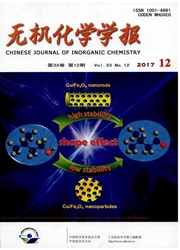

 中文摘要:
中文摘要:
本工作研究不同过程还原的氧化石墨rGO/ZnO(reduced graphiteoxide/ZnO)复合膜的可见光激发光电转换性能。氧化石墨(GO)经KOH还原处理或NaBH4还原处理后,和氧化锌溶胶混合,通过旋涂法和热处理在F掺杂SnO2薄膜导电玻璃(FTO)衬底上形成复合薄膜。采用XRD、FTIR、FE-SEM、XPS、UV-Vis等方法对复合薄膜的晶相结构、微观形貌等进行表征,并测试了复合薄膜在可见光照射下的光电转换性能。GO的预处理过程对复合薄膜的结构影响显著,采用NaBH4对GO处理更有利于形成均匀薄膜。光电流测试结果表明不同复合薄膜均能实现可见光照射下产生光电流,其原理为rGO的光激发电子跃迁到ZnO,而空穴在rGO中迁移,在rGO与ZnO界面实现光生载流子分离。其中NaBH4处理后的rGO/ZnO复合薄膜光电流密度最大,达6×10-7A·cm-2。
 英文摘要:
英文摘要:
The rGO/ZnO(reduced graphite oxide/ZnO) composite films were synthesized by using different reduction treated graphite oxides(GOs) as precursors, and then their visible-light excitation photoelectric conversion performance was investigated. In this work, we used the two reducing agents, KOH or NaBH4, to reduce graphite oxide, then the reduced graphite oxide was mixed with zinc oxide sol. rGO/ZnO composite films were prepared by spin-coating and heat treatment on FTO(fluorine-doped tin oxide)conductive glass substrates.The as-prepared samples were characterized by XRD, FTIR, FE-SEM, XPS, UV-Vis, etc. Pretreatment process of graphite oxide had a great influence on the structure of composite films, reduction treatment by Na BH4 was more conducive to form a uniform thin film. Photocurrent test results showed that different composite films can produce photocurrent under visible-light irradiation, the principle was photo-excited electron transition from rGO to ZnO to achieve the separation of photo-generated carriers. The GO after Na BH4-reduction with ZnO composite film showed the largest photocurrent density with a value of 6×10-7A·cm-2.
 同期刊论文项目
同期刊论文项目
 同项目期刊论文
同项目期刊论文
 Relationship between spatter formation and dynamic molten pool during high-power deep-penetration la
Relationship between spatter formation and dynamic molten pool during high-power deep-penetration la Deformation control during the laser welding of a Ti6Al4V thin plate using a synchronous gas cooling
Deformation control during the laser welding of a Ti6Al4V thin plate using a synchronous gas cooling Energy efficiency evaluation of hot-wire laser welding based on process characteristic and power con
Energy efficiency evaluation of hot-wire laser welding based on process characteristic and power con 期刊信息
期刊信息
